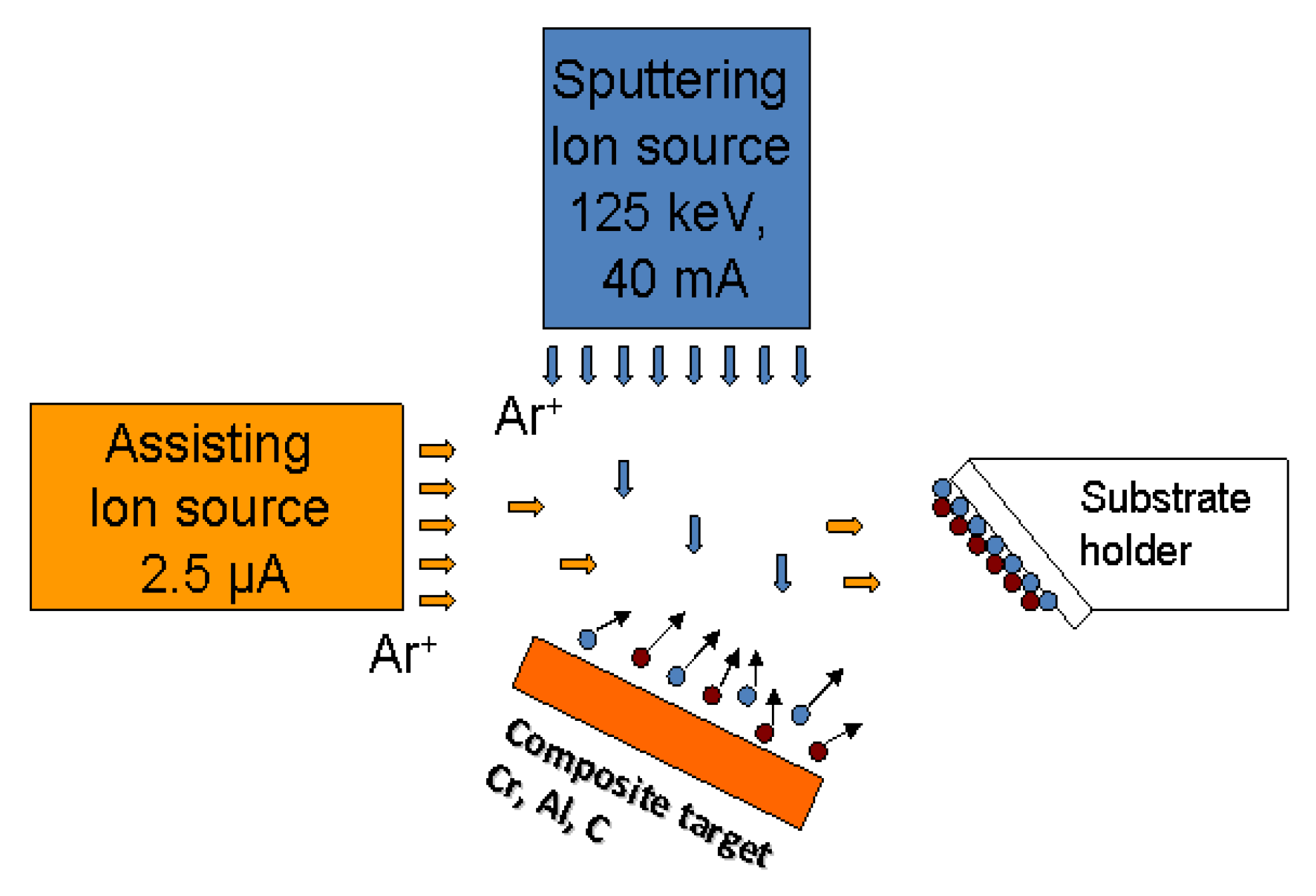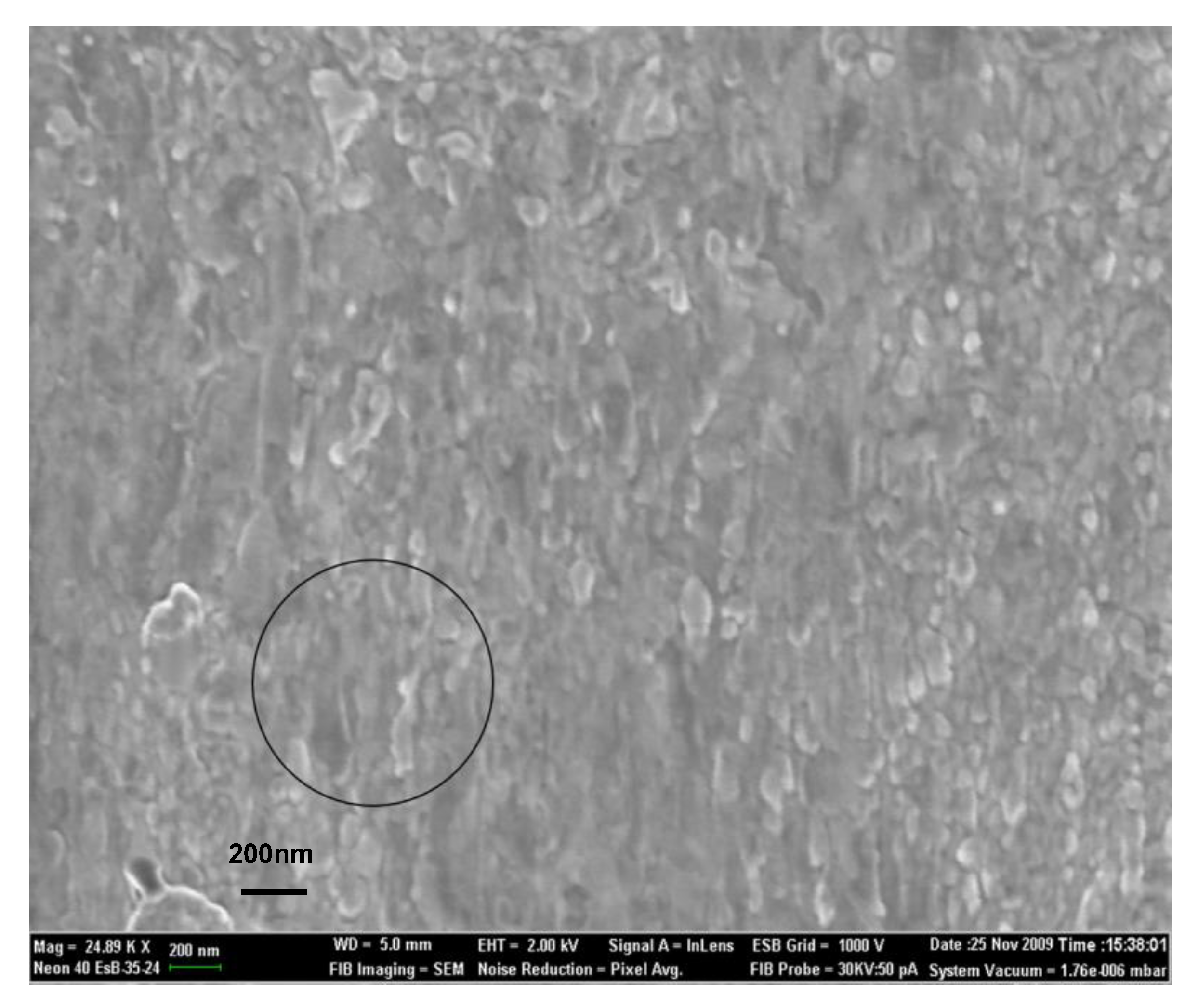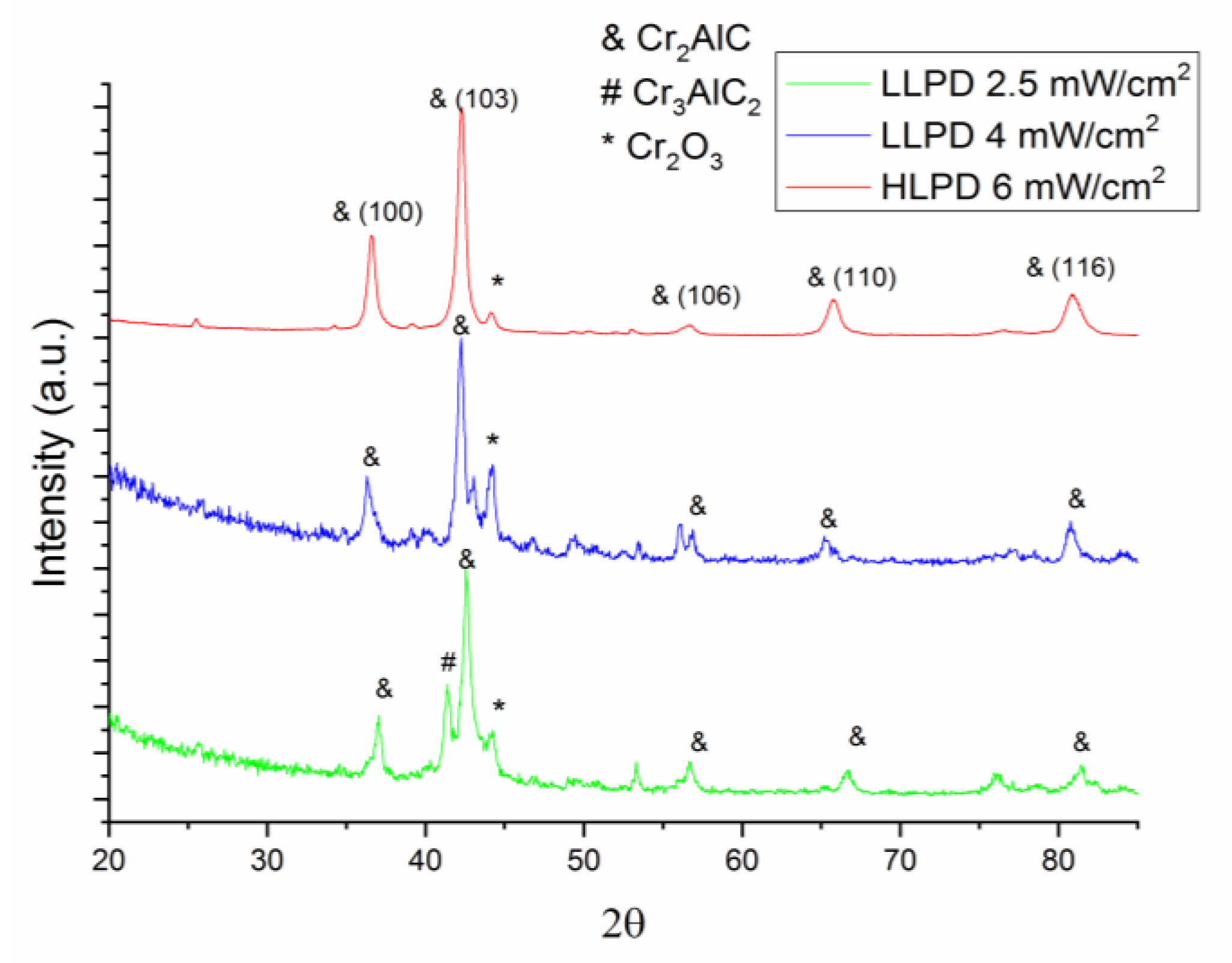Microcrystallization Effects Induced by Laser Annealing in Cr-Al-C Ion-Beam-Sputtered Films
Abstract
:1. Introduction
2. Materials and Methods
2.1. Synthesis
2.2. Characterization
3. Results
3.1. Composition and Morphology
3.2. Raman Analysis
3.3. Structural Analysis
3.4. Elastic Properties
4. Discussion
5. Conclusions
Author Contributions
Funding
Data Availability Statement
Conflicts of Interest
References
- Velasco, B.; Gordo, E.; Hu, L.; Radovic, M.; Tsipas, S.A. Influence of porosity on elastic properties of Ti2AlC and Ti3SiC2 MAX phase foams. J. Alloy. Compd. 2018, 764, 24–35. [Google Scholar] [CrossRef]
- Gonzalez-Julian, J.; Go, T.; Mack, D.E.; Vaßen, R. Thermal cycling testing of TBCs on Cr2AlC MAX phase substrates. Surf. Coat. Technol. 2018, 340, 17–24. [Google Scholar] [CrossRef]
- Jeitschko, W.; Nowotny, H.; Benesovsky, A. Kohlenstoffhaltige ternäre Verbindungen (H-Phase). Monash. Chem. 1963, 94, 672–676. [Google Scholar] [CrossRef]
- Barsoum, M.W.; El-Raghy, T. The MAX Phases: Unique New Carbide and Nitride Materials. Amer. Sci. 2001, 89, 334–343. [Google Scholar] [CrossRef]
- Eklund, P.; Beckers, M.; Jansson, U.; Hogberg, H.; Hultman, L. The Mn+1AXn phases: Materials science and thin-film processing. Thin Solid Films 2009, 518, 1851–1878. [Google Scholar] [CrossRef] [Green Version]
- Schneider, J.M.; Sun, Z.; Mertens, R.; Uestel, F.; Ahuja, R. Ab initio calculations and experimental determination of the structure of Cr2AlC. Solid State Commun. 2004, 130, 445–449. [Google Scholar] [CrossRef]
- Mertens, R.; Sun, Z.; Music, D.; Schneider, J.M. Effect of the Composition on the Structure of Cr-Al-C Investigated by Combinatorial Thin Film Synthesis and ab Initio Calculations. Adv. Eng. Mater. 2004, 6, 903–907. [Google Scholar] [CrossRef]
- Walter, C.; Sigumonrong, D.P.; El-Raghy, T.; Schneider, J.M. Towards large area deposition of Cr2AlC on steel. Thin Solid Films 2006, 515, 389–393. [Google Scholar] [CrossRef]
- Shtansky, D.V.; Kiryukhantsev-Korneev, P.V.; Sheveyko, A.N.; Mavrin, B.N.; Rojas, C.; Fernandez, A.; Levashov, E.A. Comparative investigation of TiAlC(N), TiCrAlC(N), and CrAlC(N) coatings deposited by sputtering of МАХ-phase Ti2−x CrxAlC targets. Surf. Coat. Technol. 2009, 203, 3595–3609. [Google Scholar] [CrossRef]
- Li, J.J.; Hu, L.F.; Li, F.Z.; Li, M.S.; Zhou, Y.C. Variation of microstructure and composition of the Cr2AlC coating prepared by sputtering at 370 and 500 °C. Surf. Coat. Technol. 2010, 204, 3838–3845. [Google Scholar] [CrossRef]
- Wang, Q.M.; Flores Renteria, A.; Schroeter, O.; Mykhaylonka, R.; Leyens, C.; Garkas, W.; to Baben, M. Fabrication and oxidation behavior of Cr2AlC coating on Ti6242 alloy. Surf. Coat. Technol. 2010, 204, 2343–2352. [Google Scholar] [CrossRef]
- Crisan, O.; Crisan, A.D. Effects in Cr-Al-C Intermetallic Alloys. J. Alloy. Compd. 2011, 509, 6522–6527. [Google Scholar] [CrossRef]
- Crisan, O.; Crisan, A.D.; Randrianantoandro, N.; Nicula, R.; Burkel, E. Crystallization processes and phase evolution in amorphous Fe-Pt-Nb-B alloys. J. Alloys Compd. 2007, 440, L3–L7. [Google Scholar] [CrossRef]
- Crisan, O.; Le Breton, J.M.; Nogues, M.; Machizaud, F.; Filoti, G. Magnetism and phase structure of crystallized Sm–Fe–B melt spun ribbons. J. Phys. Condens. Matter. 2002, 14, 12599–12609. [Google Scholar] [CrossRef]
- Najm, M.M.; Al-Hiti, A.S.; Nizamani, B.; Zhang, P.; Arof, H.; Rosol, A.H.A.; Yasin, M.; Haruna, S.W. Ultrafast laser soliton mode-locked at 1.5 µm region based on Cr2AlC MAX phase as a saturable absorber. Opt. Eng. 2021, 60, 066116. [Google Scholar] [CrossRef]
- Huang, J.X.; Wan, H.J.; Li, M.; Zhang, Y.M.; Zhu, J.F.; Li, X.L.; Shui, W.C.; Li, Y.; Fan, X.M.; Wen, Q.Y. In-situ growth of MAX phase coatings on carbonised wood and their terahertz shielding properties. J. Adv. Ceram. 2021, 10, 1291. [Google Scholar] [CrossRef]
- Zakeri-Shahroudi, F.; Ghasemi, B.; Abdolahpour, H.; Razavi, M. Sintering behavior of Cr2AlC MAX phase synthesized by Spark plasma sintering. Int. J. Appl. Ceram. 2022, 19, 1309–1318. [Google Scholar] [CrossRef]
- Ougier, M.; Michau, A.; Schuster, F.; Maskrot, H.; Schlegel, M.L. Effects of HiPIMS discharges and annealing on Cr-Al-C thin films. Surf. Coat. Technol. 2020, 399, 126141. [Google Scholar] [CrossRef]
- Lin, Z.J.Y.; Zhou, C.; Li, M.S. Synthesis, microstructure, and property of Cr2AlC. J. Mater. Sci. Technol. 2007, 23, 712–746. [Google Scholar]
- Rubshtein, A.P.; Gao, K.; Vladimirov, A.B.; Plotnikov, S.A.; Zhang, B.; Zhang, J. Structure, wear and corrosion behaviours of Cr–Al–C and multilayer [Cr–Al–C/a-C]n coatings fabricated by physical vapour deposition and plasma-assisted chemical vapour deposition techniques. Surf. Coat. Technol. 2019, 377, 124912. [Google Scholar] [CrossRef]
- Wang, C.J.; Tu, H.J.; Su, R.R.; Gao, J.; King, B.V.; O’Connor, D.J.; Shi, L.Q. Annealing effects on the structure and hardness of helium-irradiated Cr2AlC thin films. J. Amer. Ceram. Soc. 2021, 104, 593–603. [Google Scholar] [CrossRef]
- Crisan, O.; Crisan, A.D. Incipient low temperature formation of MAX phase in Cr-Al-C films. J. Adv. Ceram. 2018, 7, 143–151. [Google Scholar] [CrossRef] [Green Version]
- Crisan, A.D.; Crisan, O. Morpho-Structural Investigations and Carbon Nanoclustering Effects in Cr-Al-C Intermetallic Alloys. Nanomaterials 2022, 12, 3225. [Google Scholar] [CrossRef] [PubMed]
- Crisan, O.; Crisan, A.D. Elastic properties and crystallization of thermal barrier coatings of Cr2AlC. Dig. J. Nanomater. Biostruct. 2017, 12, 1165–1174. [Google Scholar]
- Eklund, P.; Mikkelsen, N.J.; Bottiger, J. Chromium oxide-based multilayer coatings deposited by reactive magnetron sputtering in an industrial setup. Surf. Coat. Technol. 2008, 203, 156–159. [Google Scholar] [CrossRef]
- Son, Y.-I.; Shin, J. Numerical Study on the Laser Annealing of Silicon Used in Advanced V-NAND Device. Materials 2022, 15, 4201. [Google Scholar] [CrossRef]
- Novotný, M.; Remsa, J.; Havlová, Š.; More-Chevalier, J.; Irimiciuc, S.A.; Chertopalov, S.; Písařík, P.; Volfová, L.; Fitl, P.; Kmjec, T.; et al. In Situ Monitoring of Pulsed Laser Annealing of Eu-Doped Oxide Thin Films. Materials 2021, 14, 7576. [Google Scholar] [CrossRef]
- Latronico, G.; Mele, P.; Artini, C.; Manfrinetti, P.; Pan, S.W.; Kawamura, Y.; Sekine, C.; Singh, S.; Takeuchi, T.; Baba, T.; et al. Investigation on the Power Factor of Skutterudite Smy(FexNi1−x)4Sb12 Thin Films: Effects of Deposition and Annealing Temperature. Materials 2021, 14, 5773. [Google Scholar] [CrossRef]
- Tokuda, T.; Tsuruda, R.; Hara, T.; Hou, Z.; Kobayashi, H.; Tanaka, K.; Takarada, W.; Kikutani, T.; Hinestroza, J.P.; Razal, J.M.; et al. Planar or Biaxial Stretching of Poly(ethylene terephthalate) Fiber Webs Prepared by Laser-Electrospinning. Materials 2022, 15, 2209. [Google Scholar] [CrossRef]
- Setzer, A.; Esquinaz, P.D.; Buga, S.; Georgieva, M.T.; Reinert, T.; Venus, T.; Eestrela-Lopis, I.; Ivashenko, A.; Bondarenko, M.; Böhlmann, W.; et al. Nanometers-Thick Ferromagnetic Surface Produced by Laser Cutting of Diamond. Materials 2022, 15, 1014. [Google Scholar] [CrossRef]
- Raman, R.N.; Matthews, M.J.; Adams, J.J.; Demos, S.G. Monitoring annealing via CO2 laser heating of defect populations on fused silica surfaces using photoluminescence microscopy. Opt. Express 2010, 18, 15207–15215. [Google Scholar] [CrossRef] [PubMed]
- Jahn, R.; Steenhusen, S.; Löbmann, P. Thermal Annealing and Laser Treatment of Sol-gel Derived Zirconia Thin Films. Lasers Manuf. Mater. Process. 2020, 7, 234–243. [Google Scholar] [CrossRef]
- Zimmerer, N.; Kiefer, W. Rotating Surface Scanning Technique for Raman Spectroscopy. Appl. Spectrosc. 1974, 28, 279–281. [Google Scholar] [CrossRef]
- Spanier, J.E.; Gupta, S.; Amer, M.; Barsoum, M.W. Vibrational behavior of the Mn+1AXn phases from first-order Raman scattering (M = Ti,V,Cr, A = Si, X = C,N). Phys. Rev. B 2005, 71, 012103. [Google Scholar] [CrossRef] [Green Version]
- Leaffer, O.D.; Gupta, S.; Barsoum, M.W.; Spanier, J.E. On Raman scattering from selected M2AC compounds. J. Mater. Res. 2007, 22, 2651–2654. [Google Scholar] [CrossRef]
- Kajikawa, J. Texture development of non-epitaxial polycrystalline ZnO films. J. Cryst. Growth 2006, 289, 387–394. [Google Scholar] [CrossRef]
- Lin, Z.J.; Li, M.S.; Wang, J.Y.; Zhou, Y.C. High-temperature oxidation and hot corrosion of Cr2AlC. Acta Mater. 2007, 55, 6182–6191. [Google Scholar] [CrossRef]
- Ferrari, A.C. Raman spectroscopy of graphene and graphite: Disorder, electron–phonon coupling, doping and nonadiabatic effects. Solid State Commun. 2007, 143, 47–57. [Google Scholar] [CrossRef]
- Musa, G.; Vladoiu, R.; Ciupina, V.; Janik, J. Raman spectra of carbon thin films. J. Optoelectron. Adv. Mat. 2006, 8, 621–623. [Google Scholar]
- Wang, J.; Zhou, Y.; Lin, Z.; Meng, F.; Li, F. Raman active phonon modes and heat capacities of Ti2AlC and Cr2AlC ceramics: First-principles and experimental investigations. Appl. Phys. Lett. 2005, 86, 101902–101905. [Google Scholar] [CrossRef]
- Ivanov, V.G.; Hadjichristov, G.B. Orientation of sp2 carbon nanoclusters in ion-implanted polymethylmethacrylate as revealed by polarized Raman spectroscopy. J. Raman Spectrosc. 2011, 42, 1340–1343. [Google Scholar] [CrossRef]
- Matthies, S.; Lutterotti, L.; Wenk, H.R. Advances in texture analysis from diffraction spectra. J. Appl. Cryst. 1997, 30, 31–42. [Google Scholar] [CrossRef]
- Warren, B.E. X-ray Diffraction; Addison Wesley, Reading: Boston, MA, USA, 1969. [Google Scholar]
- Klug, H.P.; Alexander, L.E. X-ray Diffraction Procedures for Polycrystalline and Amorphous Materials, 2nd ed.; John Wiley: New York, NY, USA, 1975; Volume 79, p. 553. [Google Scholar]
- Seqqat, M.; Nogues, M.; Crisan, O.; Kuncser, V.; Cristea, L.; Jianu, A.; Filoti, G.; Dormann, J.L.; Sayah, D.; Godinhod, M. Magnetic properties of Fe100−xSmx thin films and Fe80−xSmxB20 thin films and ribbons. J. Magn. Magn. Mater. 1996, 157, 225–226. [Google Scholar] [CrossRef]
- Crisan, O.; von Haeften, K.; Ellis, A.M.; Binns, C. Structure and magnetic properties of Fe/Fe oxide clusters. J. Nanopart. Res. 2008, 10, 193–199. [Google Scholar] [CrossRef] [Green Version]
- Crisan, O.; Angelakeris, M.; Flevaris, N.K. Magnetism and anisotropy in core-shell nanoparticles. J. Optoelectron. Adv. Mat. 2003, 5, 959–962. [Google Scholar]
- Crisan, O.; Le Breton, J.M.; Filoti, G. Nanocrystallization of soft magnetic Finemet-type amorphous ribbons. Sens. Actuators A 2003, 106, 246–250. [Google Scholar] [CrossRef]
- Crisan, O.; Labaye, Y.; Berger, L.; Greneche, J.M.; Coey, J.M.D. Exchange coupling effects in nanocrystalline alloys studied by Monte Carlo simulation. J. Appl. Phys. 2002, 91, 8727–8729. [Google Scholar] [CrossRef]
- Crisan, O.; Greneche, J.M.; Le Breton, J.M.; Crisan, A.D.; Labaye, Y.; Berger, L. Magnetism of nanocrystalline Finemet alloy: Experiment and simulation. Eur. Phys. J. B 2003, 34, 155–162. [Google Scholar] [CrossRef]
- Crisan, O.; Le Breton, J.M.; Jianu, A.; Teillet, J.; Filoti, G. Structural properties of amorphous and nanocrystallized Fe-Cu-Nb-Si-B and Fe-Gd-Cu-Nb-Si-B ribbons. J. Alloys Compd. 1997, 262, 381–389. [Google Scholar] [CrossRef]
- Crisan, A.D.; Crisan, O. Direct formation of L1(0) FePt in as-cast FePt-based magnetic nanocomposite ribbons without post-synthesis annealing. J. Phys. D-Appl. Phys. 2011, 44, 365002. [Google Scholar] [CrossRef]
- von Haeften, K.; Binns, C.; Brewer, A.; Crisan, O.; Howes, P.B.; Lowe, M.P.; Sibbley-Allen, C.; Thornton, S.C. A novel approach towards the production of luminescent silicon nanoparticles: Sputtering, gas aggregation and co-deposition with H2O. Eur. Phys. J. D 2009, 52, 11–14. [Google Scholar] [CrossRef]
- Schneider, J.M.; Sigumonrong, D.P.; Music, D.; Walter, C.; Emmerlich, J.; Iskandar, R.; Mayer, J. Elastic properties of Cr2AlC thin films probed by nanoindentation and ab initio molecular dynamics. Scr. Mater. 2007, 57, 1137–1140. [Google Scholar] [CrossRef]
- Tian, W.; Wang, P.; Zhang, G.; Kan, Y.; Li, Y.; Yan, D. Synthesis and thermal and electrical properties of bulk Cr2AlC. Scr. Mater. 2006, 54, 841–846. [Google Scholar] [CrossRef]
- Tabares, E.; Kitzmantel, M.; Neubauer, E.; Jimenez-Morales, A.; Tsipas, S.A. Sinterability, Mechanical Properties and Wear Behavior of Ti3SiC2 and Cr2AlC MAX Phases. Ceramics 2022, 5, 6. [Google Scholar] [CrossRef]
- Knight, D.S.; White, W. Characterization of diamond films by Raman spectroscopy. J. Mater. Res. 1989, 4, 385. [Google Scholar] [CrossRef]
- Cancado, L.G.; Takai, K.; Enoki, T. General equation for the determination of the crystallite size La of nanographite by Raman spectroscopy. Appl. Phys. Lett. 2006, 88, 163106. [Google Scholar] [CrossRef]






| Peak no. | 1a | 1b | 1c | 1d | 2 | 3a | 3b | 3c | 3a | 3b |
| LLPD 2.5 mW/cm2 | 179 | 242 | - | 336 | - | - | 662 | 810 | - | - |
| LLPD 4 mW/cm2 | 177 | 241 | - | 338 | - | - | 663 | 809 | - | - |
| HLPD 6 mW/cm2 | 165 | 248 | 304 | 347 | 548 | 598 | 686 | 805 | 1362 | 1568 |
| Sample | Lattice Parameters | Cryst. Size | Microstrain | ||
|---|---|---|---|---|---|
| a (Å) | c (Å) | V (nm3) | (nm) | (%) | |
| LLPD at 2.5 mW/cm2 | 2.884 ± 0.011 | 13.42 ± 0.03 | 0.097 | 34 ± 4 | 0.79 ± 0.03 |
| LLPD at 4 mW/cm2 | 2.861 ± 0.008 | 13.15 ± 0.03 | 0.093 | 39 ± 6 | 0.42 ± 0.05 |
| HLPD at 6 mW/cm2 | 2.848 ± 0.005 | 12.69 ± 0.04 | 0.089 | 56 ± 6 | 0.31 ± 0.05 |
| Sample | Elastic Properties | |
|---|---|---|
| Hardness H (GPa) | Reduced Modulus (GPa) | |
| LLPD 2.5 mW/cm2 | 16.72 ± 0.76 | 217 ± 2 |
| LLPD 4 mW/cm2 | 19.37 ± 1.18 | 225 ± 7 |
| HLPD 6 mW/cm2 | 26.25 ± 0.71 | 261 ± 9 |
Publisher’s Note: MDPI stays neutral with regard to jurisdictional claims in published maps and institutional affiliations. |
© 2022 by the authors. Licensee MDPI, Basel, Switzerland. This article is an open access article distributed under the terms and conditions of the Creative Commons Attribution (CC BY) license (https://creativecommons.org/licenses/by/4.0/).
Share and Cite
Crisan, O.; Crisan, A.D. Microcrystallization Effects Induced by Laser Annealing in Cr-Al-C Ion-Beam-Sputtered Films. Nanomaterials 2022, 12, 4136. https://doi.org/10.3390/nano12234136
Crisan O, Crisan AD. Microcrystallization Effects Induced by Laser Annealing in Cr-Al-C Ion-Beam-Sputtered Films. Nanomaterials. 2022; 12(23):4136. https://doi.org/10.3390/nano12234136
Chicago/Turabian StyleCrisan, Ovidiu, and Alina Daniela Crisan. 2022. "Microcrystallization Effects Induced by Laser Annealing in Cr-Al-C Ion-Beam-Sputtered Films" Nanomaterials 12, no. 23: 4136. https://doi.org/10.3390/nano12234136
APA StyleCrisan, O., & Crisan, A. D. (2022). Microcrystallization Effects Induced by Laser Annealing in Cr-Al-C Ion-Beam-Sputtered Films. Nanomaterials, 12(23), 4136. https://doi.org/10.3390/nano12234136





